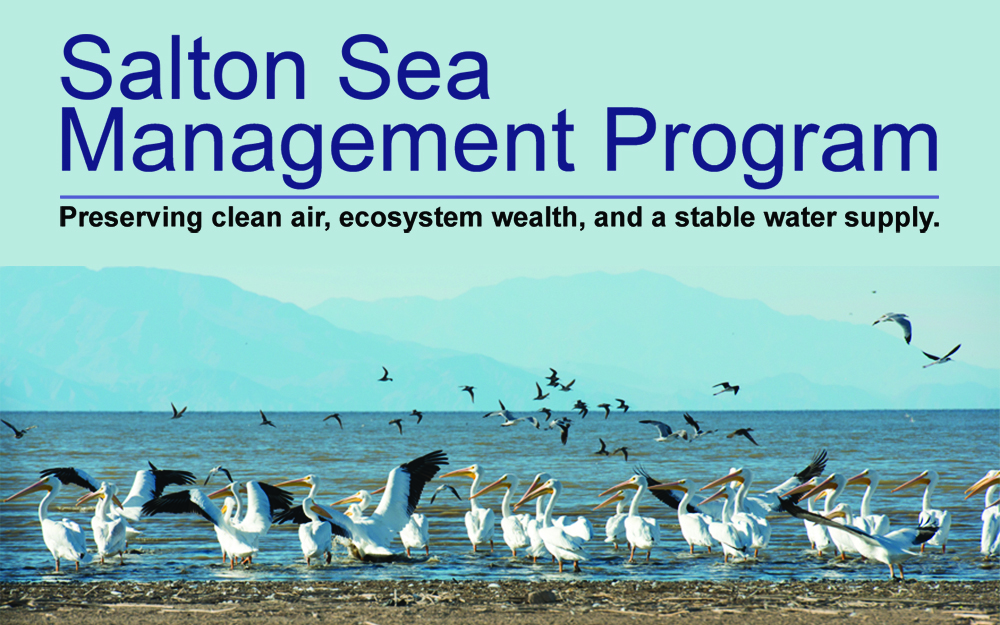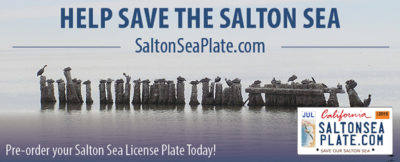
California Natural Resources Agency will unveil work plan and schedule of planned projects set to break ground in 2017
By Josh Zipperman
A series of community workshops has been scheduled to present and gather input on the implementation of State’s 10-Year Plan of the Salton Sea Management Program. The 10-Year Plan aims to quickly build projects to develop habitat and suppress dust due to rapidly receding shoreline at the Sea.
The workshops will be presented by Bruce Wilcox, Assistant Secretary of Salton Sea Policy at the California Natural Resources Agency, in partnership with the Salton Sea Authority, California Department of Water Resources, Imperial Irrigation District and the California Department of Fish & Wildlife. The presentation at these workshops will focus on the implementation of the 10-Year Plan and what it means to the communities surrounding the Sea. Status updates will be given on the existing projects at the Sea and the near-term design and construction of new projects. Projected costs and funding will also be discussed. Attendees will be encouraged to ask questions at the end of the presentation.
“These workshops will be a great opportunity for residents and stakeholders to learn about the 10-Year Plan and engage with the Salton Sea Management team on ways we could quickly implement projects in coordination with their local community,” said Bruce Wilcox.
In order to give as many residents as possible the opportunity to participate, the workshops are being held over the course of five weeks at multiple locations throughout the surrounding region of the Salton Sea. Light refreshments will be served, and everyone is welcome at any and all sessions. Spanish interpretation will be provided at the Mecca, Brawley and Indio workshops and other translation or special assistance may be provided upon request. The dates and locations of the workshops are as follows:
Tuesday June 13th
Boys & Girls Club
91391 66th Ave, Mecca, CA
Thursday June 15th
5:30 p.m. to 7:30 p.m.
West Shores Senior Citizens Club (in Salton City)
1375 S. Marina Drive,
Thermal, CA
Thursday June 22nd
5:30 p.m. to 7:30 p.m.
Del Rio Community Center
1501 I Street, Brawley, CA
Wednesday June 28th
2:00 p.m. to 4:00 p.m.
Ski Inn (in Bombay Beach)
9596 Ave. A, Niland, CA
Thursday June 29th
5:30 p.m. to 7:30 p.m.
IID District Office
1285 Broadway Street,
El Centro, CA
Thursday July 6th
5:30 p.m. to 7:30 p.m.
Indio Performing Arts Center (IPAC)
4517 Fargo Street, Indio, CA
Wednesday July 12th
5:30 p.m. to 7:30 p.m.
Rancho Mirage Public Library
71100 CA-111, Rancho Mirage, CA
The State’s 10-Year Plan, details the number of acres of lakebed expected to face exposure each year from 2018 through 2028, the number of acres to be covered through proposed construction efforts, and the projected annual costs of the effort. For more information about the workshops and the 10-Year Plan, please visit the Salton Sea Management Program web page at www.resources.ca.gov/salton-sea.
ABOUT THE SALTON SEA MANAGEMENT PROGRAM 10-YEAR PLAN
The cost of implementing the 10-Year Plan is estimated at a total of $383 million. The cost of the projects needed to cover nearly 30,000 acres of exposed lakebed over the next decade outstrip the currently available funding of roughly $80 million. But, State, federal, regional, local, tribal and philanthropic agencies will continue to seek funding in their long-term efforts to protect air quality and wildlife habitat at the Sea.
As the Salton Sea shrinks for a variety of reasons, air quality in Riverside, Imperial, and surrounding counties suffer, because particulates small enough to be dangerous to human health are picked up by the wind from the exposed lakebed. Huge populations of resident and migratory birds are at risk, too, especially the fish-eating pelicans and cormorants that depend upon the tilapia that will no longer be able to survive in the Salton Sea as it grows increasingly salty.
In May 2015, Governor Edmund G. Brown Jr. created the Salton Sea Task Force and directed agencies to develop a comprehensive management plan for the Sea that will meet a short-term goal of 9,000 acres to 12,000 acres of habitat and dust suppression projects. The Governor also set a medium-term plan to construct 18,000 acres to 25,000 acres of habitat and dust suppression projects.
The State’s 10-year plan, available here, describes the first phase of the Salton Sea Management Program created under the Governor’s direction. The plan targets areas near where the New and Alamo rivers carry agricultural drainage into the southern end of the Salton Sea, and where the Whitewater River flows into the northern end of the roughly 35-mile-long lake. The State proposes to build a series of river outlets and ponds along the lake shore so river and lake water can be blended for use in wildlife habitat zones that also will serve to suppress dust. Intermixed with these projects will be additional dry-land dust suppression projects to protect air quality on lands where habitat is not feasible.
The State’s many partners in this effort include the Salton Sea Authority, California Department of Water Resources, California Department of Fish & Wildlife, Imperial County, the Imperial Irrigation District, Riverside County, the South Coast Air Quality Management District, the Water Transfers Joint Powers Authority, the Audubon Society, Coachella Valley Water District, San Diego County Water Authority and the U.S. Bureau of Reclamation.
The habitat and air quality work will help fulfill the goals set forth in a Memorandum of Understanding reached in August between the U.S. Department of the Interior and the California Natural Resources Agency.
In addition, California has committed more than $80 million in voter-approved bond funds to restore habitat and suppress dust at the lake in the near term. A $14 million grant from the State Wildlife Conservation Board helps to fund habitat conservation at the Salton Sea, and the Salton Sea Authority will administer a $7.5 million U.S. Department of Agriculture grant for water conservation, wetland creation, and air quality mitigation. Potential sources of future funding include the Water Transfers Joint Powers Authority, created to administer funds involving a 2003 agricultural-to-urban water transfer, federal agencies and philanthropic organizations.
Inflow to the Salton Sea is expected to shrink significantly after 2017, when water transfers from the Imperial Valley accelerate and mitigation water deliveries stop under agreements reached years ago. To learn more, please visit the Salton Sea Management Program web page at www.resources.ca.gov/salton-sea.











































